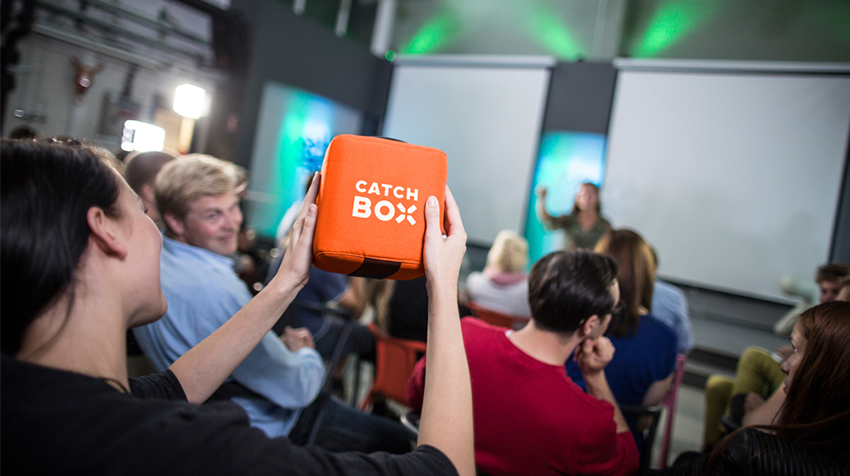
Experiences with the ‘throwing microphone’ Catchbox in UvA education
The Catchbox is a wireless microphone in the shape of a soft cube, which you throw at each other. This throw microphone, as it is popularly called, makes communicating easier, more fun and faster during lectures. Because you throw the microphone at the questioner or speaker, it saves time. Participants no longer have to walk to the microphone. In addition, they can be heard well immediately via a Catchbox and the producer mentions as an additional advantage that participants stay focused better, because the Catchbox can come at you unexpectedly. Having already proven its services at conferences for years, the throwing microphone is also available at the UvA. Prof. dr. Hilde Geurts (FMG Psychology) used this microphone for one lecture. Dr. Vincent de Rooij (FMG Sociology, Anthropology and AISSR) regularly uses this microphone. They talk about their findings.
Hilde Geurts
With a Catchbox you can hear speakers well
“I know the Catchbox from conferences years ago and it always worked well there. The sound of this type of microphone is very good. I got involved in a first-year course of the undergraduate Psychology course with more than 400 students.”

“I thought it would be fun to see whether this microphone would also work in a lecture. Especially because sometimes you can’t hear the questions students ask very well. Sometimes, fellow students can’t hear the questions properly either, which is something this microphone solves; at least with a Catchbox, you can hear the speakers properly. Whether the students stay with the class better is a bit premature for me to judge, as I have only used the Catchbox once.”
Throwing a microphone takes some getting used to and is a bit exciting
“People have laptops in front of them and of course you don’t want to hit them. So far, using the Catchbox has not caused any craziness or hilarity, but I have only used the microphone once. Of course, if someone has no throwing or catching skills, you can always let the person next to you catch or throw. Anyway, most don’t manage to throw or aim precisely. You can also pass it on. I feel that throwing became easier during the lecture, but at the same time we collectively also forgot to use it again sometimes.”
Recommended or not?
“I need to try the microphone more often before I can recommend it to colleagues. But I definitely want to use the Catchbox again next academic year during first-year lectures.”

Vincent de Rooij

More interaction with the students, a more informal atmosphere and better sound recordings
“I used the Catchbox occasionally in previous years, but this year I used this microphone at every lecture. The lecture in question was Introduction to Cultural Anthropology with usually around 120 students in the room.”
“I wanted to interact more with them and make sure that answers from students to my questions or their questions to me were audible to everyone and included in the audio recording of the lecture. So those are the advantages of this microphone for me. In addition, in general, this microphone also creates a more informal atmosphere in the room. I think students are definitely kept on task if you use the box structurally. In lectures with some more questions on my part, an effect is noticeable. Some of my lectures are more interactive than others; it depends a bit on the lecture material and how much time I have for interaction.”
Throwing in a high arc to spare the laptops
“At first, throwing the box led to hilarity but that quickly subsided. Now students are used to it. In fact – remarkably – there have been no accidents yet. I haven’t experienced any spectacular things in using this microphone. For myself, though, throwing is sometimes tricky with all the expensive Macs unfolded, so I try to throw in a high arc to spare the laptops. The box is also quite a while away and before I throw I make it clear when and where I am throwing.
If I ask a question and students raise their hand when they want to answer, I also often walk towards them with the box instead of throwing the box.”
Recommended or not?
“I would definitely encourage colleagues considering using the box to take the plunge. If students speak properly and clearly into the microphone, the sound is fine. In the beginning, I did occasionally have to really make it clear that it is important to keep the microphone close to the mouth. That’s why it’s useful to explain to students at the beginning of the lecture how the microphone works. A tip for the producers of facility services: perhaps it would be useful to put an arrow with an icon on the cube, so that students immediately hold the cube correctly, and know where the microphone is, so that they speak on the right side.”
The Catchbox is already widely used in lectures and can be requested via the Facility Services Service Desk:
T: +31 (0)20 525 1403
E: servicedesk-fs@uva.nl
More information about Prof. dr. Hilde M. Geurts:
- Professor of Clinical Neuropsychology
- UvA Profile
- Dutch Autism & ADHD research centre (d’Arc), Brain & Cognition
- Department of Psychology, University of Amsterdam
- Website | www.dutcharc.nl
- Twitter |@dutcharc
More information about Dr. Vincent de Rooij:
- MA in Anthropology and PhD in Linguistics
- UvA Profile
- Personal website





